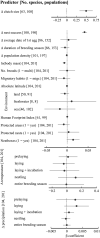The effect of climate change on avian offspring production: A global meta-analysis
- PMID: 37126701
- PMCID: PMC10175715
- DOI: 10.1073/pnas.2208389120
The effect of climate change on avian offspring production: A global meta-analysis
Abstract
Climate change affects timing of reproduction in many bird species, but few studies have investigated its influence on annual reproductive output. Here, we assess changes in the annual production of young by female breeders in 201 populations of 104 bird species (N = 745,962 clutches) covering all continents between 1970 and 2019. Overall, average offspring production has declined in recent decades, but considerable differences were found among species and populations. A total of 56.7% of populations showed a declining trend in offspring production (significant in 17.4%), whereas 43.3% exhibited an increase (significant in 10.4%). The results show that climatic changes affect offspring production through compounded effects on ecological and life history traits of species. Migratory and larger-bodied species experienced reduced offspring production with increasing temperatures during the chick-rearing period, whereas smaller-bodied, sedentary species tended to produce more offspring. Likewise, multi-brooded species showed increased breeding success with increasing temperatures, whereas rising temperatures were unrelated to reproductive success in single-brooded species. Our study suggests that rapid declines in size of bird populations reported by many studies from different parts of the world are driven only to a small degree by changes in the production of young.
Keywords: birds; climate change; meta-analysis; offspring production.
Conflict of interest statement
The authors declare no competing interest.
Figures




References
-
- IPCC, Climate change 2021: The physical science basis. Contribution of working group I to the sixth assessment report of the intergovernmental panel on climate change, Masson-Delmotte V., et al., Eds. (Cambridge University Press, Cambridge, UK and New York, NY, 2021), in press. 10.1017/9781009157896. - DOI
-
- Jylhä K., et al. , Observed and projected future shifts of climatic zones in Europe and their use to visualize climate change information. Weather Clim. Society 2, 148–167 (2010).
-
- Parmesan C., Yohe G., A globally coherent fingerprint of climate change impacts across natural ecosystems. Nature 421, 37–42 (2003). - PubMed
-
- Dunn P. O., Møller A. P., Effects of climate change on birds (Oxford University Press, Oxford, New York, ed. 2, 2019).
Publication types
MeSH terms
LinkOut - more resources
Full Text Sources
Medical

